Dryocopus pileatus
The pileated woodpecker is North America’s largest woodpecker with the best looking hairstyle.
Description
These punk-rockers are mostly black with white stripes on the face and a distinguishable red crest on the top of the head. They have a long chisel-like bill and a black stripe through the eye. Like I mentioned before, they are North America’s largest woodpeckers. They have a body of 40-49 cm, 66-75 cm wingspan, and weigh in at 250-350 grams!
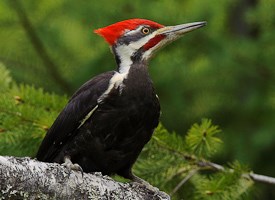
“Who are you calling large?!” Male Pileated Woodpecker looking proud, not giving into the forest’s unrealistic beauty standards.
To distinguish sex, males have a red patch on their cheek, and a red crest extending down to the base of the bill. Females on the other hand have white markings down their neck, and a shorter crest.
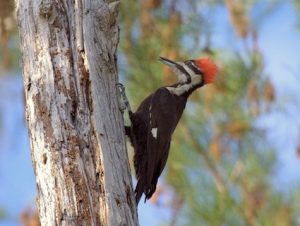
Gorgeous adult female. What she lacks in cheek colour, she makes up for with a perfectly pale neckline.
Watch out for imposters! Many species may look similar and cause confusion, especially to novice birders.
These guys are also present in North American forests. Coming in with a body length of 16.5 cm (downy) and 25.4 cm (hairy) the size alone is enough to rule them out. They are also commonly confused as “babies”- stay tuned for more info on juvenile Pileateds.
This red-breasted sap-sucker may also be mis-identified as our Pileated. Instead of a rocking mohawk, these guys opt for an entire head and breast full of bright red plumage. Go big or go home!
These two share very similar characteristics: cloaked in all black, red crest, often seen “head banging”. The two can be distinguished by the punk rocker’s call of Ramones lyrics and an attraction to studded leather. Who wore it better? My votes for the Woodpecker.
in-flight identification
The Pileated Woodpecker flies in what is referred to as an “undulating flight pattern”. The most energy efficient for their body size, they flap the wings multiple times in short bursts, then bring them in to glide for a short rest.
From below, Pileated Woodpeckers can be identified through the large white patches on the underwing
From above, they can be identified by small white crescents on the base of the primaries.
In-flight ID can be difficult for any birder, and the most common mis-identification of Pileated is when they get confused with the North American Crow. Just look for those white patches or a characteristic flight pattern and I guarantee you will do just fine!

North American Crow in flight. With similar size and body morphology, it is easy to confuse with a Pileated Woodpecker
Sounds
The Pileated Woodpecker can be identified by its distinct call, alongside a unique “drumming” on the trunks of trees. Not to be confused with the tapping associated with feeding, this drum is utilized by both sexes for a variety of functions including mate summoning and territorial claim. Below are two videos showcasing the calls, as well as this spectacular drum-solo.
Interested in how Woodpeckers thrive despite multiple blows to the head? Does this distinctive call sound familiar? Check out my next post for more information on some neat adaptations for injury prevention and for a cool piece of trivia to impress your friends!
Habitat
Pileated woodpecker spend their lives as permanent residents in mixed deciduous forests throughout North America.
They enjoy a variety of living and dead trees in which they can feed and raise their young. Woodlots and mature forests are of particular preference, however they can be found in young forests as long as there are enough large, dead trees for feeding and brooding.
Feeding and behaviour
The most unifying features of woodpeckers is their ability to continuously strike trees in order to obtain their food beneath the bark’s surface. A personal favourite of Pileated Woodpeckers is the carpenter ant. They can be often seen gouging deep holes in dead wood in order to get at the carpenter ant nests that lie within.
As you can see above, the Pileated woodpecker uses it’s long neck to pull away from the tree in order to make powerful strikes against the wood. They use their large bills to pick away and feed at what is inside. They use their large, clawed feet as support to increase the strength of the blow.
Alongside being Nature’s rockstars, Pileated Woodpeckers are master carvers. Once established, these birds can make short work of even the tallest of trees. Here is a local example of photos taken at Hemer Park in Cedar, BC. For a trail map where you yourself can start your birding quest click here!
UPDATE NOVEMBER 2017: The tree is no longer with us! Our pair of pileateds have finalized their work on this tree. It has completely broken in half! All that is left is a stub of what used to be, and the top half is blocking the path. It’s amazing what these guys can accomplish in a matter of months, talk about ecosystem engineers!
Aside from insects, the Pileated Woodpecker has also been seen on branches feeding on berries, and in backyard suet feeders. If you want to attract more of nature’s excavators, click here.
Nesting and brooding
Pileateds mate for life and remain in the same pair for the entire year, making a new nest for their young every breeding season. The pair defend their territory with the drumming mentioned above. The nests are made in dead trees 15-20 feet from the base, and can get up to a foot long.
Once the nest is made and the mood is set, the female will lay around 3-5 eggs per clutch. Both parents feed their young via regurgitation for 26-29 days after hatching. The young will remain with their parents for 2-3 months before fledging.

Hungry babies waiting for their next meal. Note their young red crests, comparable to our imposters above!
conservation status
Among many species, this is typically quite a somber topic. But when it comes to Pileateds, they are one of the lesser concerns of our forest species. Don’t get me wrong, no one is safe from the great wrath of the human race. Populations declined sharply in the 18 and 19th century with the mass clearance of Eastern forests. Now, however, thanks to laws and the hard work of conservation biologists, the Pileated Woodpecker has been on a steady increase from 1966 to present day. The current population estimate is around 9 million in North America, with 33% of them residing in Canada!
If you’d like to learn more about Pileated Woodpeckers, and get involved in some super cool citizen science projects, check out the links below!

References:
2015. All About Birds: Pileated Woodpecker. Cornell Lab of Ornithology, Ithaca, New York, USA. Retrieved from: https://www.allaboutbirds.org/guide/Pileated_Woodpecker/id
2017. Guide to North American Birds: Pileated Woodpecker. National Auburn Society, Inc., New York, New York, USA. Retrieved from: http://www.audubon.org/field-guide/bird/pileated-woodpecker
All photos contain links to original source.
/pileated-woodpecker-58a6d9043df78c345b5d6ece.jpg)
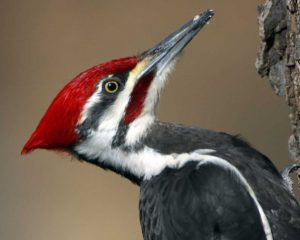
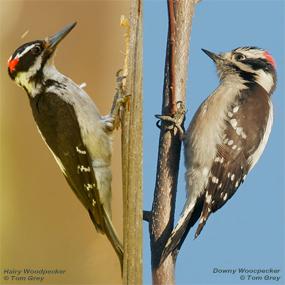
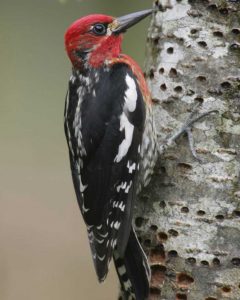

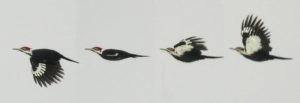



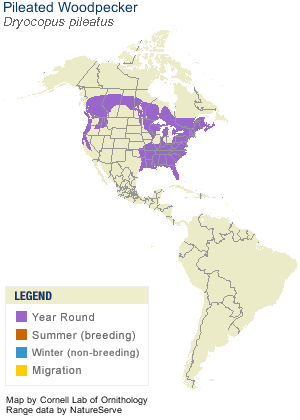
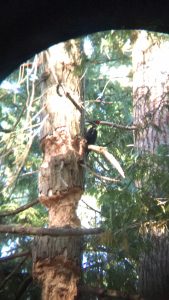
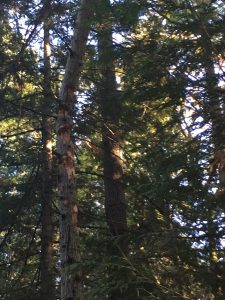
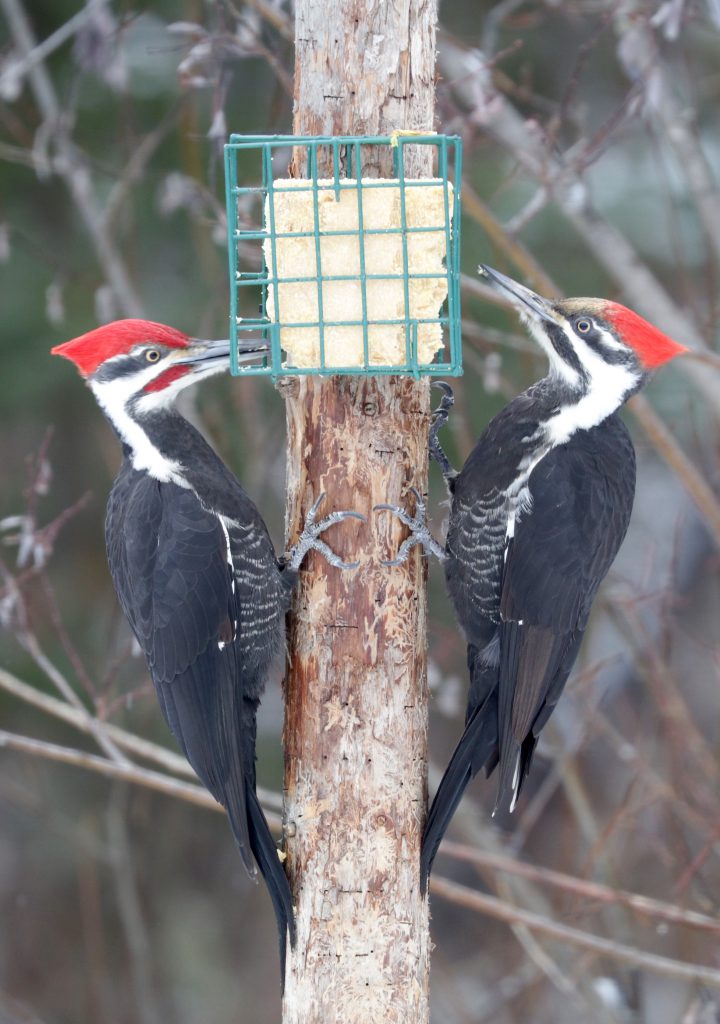
They totally do look like punk rockers! It looks like the babies have the “do” but without the gel, so do they grow those bright red crown feathers soon after hatching then?
Hi Christina, to answer your question, the crest is grown during the growth of their juvenile plumage, in which they fledge. Below is a photo of a few juveniles just to show how vibrant the crest is as such a young age. (if the photo doesn’t show here is a link to the site of the original photo: https://rakmilphotography.wordpress.com/2015/08/26/pileated-woodpecker-chicks-eight-photographs/)
Nice post Brianna. I found it really interesting that they build a new nest every year, even though they are non-migratory and presumably do not stray too far from their territories… Is this because they cannot trust dead trees to last from year to year?
Hi Hannah, to answer your question, the woodpeckers make a new nest every year simply because the nook they have created cannot withstand multiple uses (it is dead wood after all). Many raptors re-use their nests because they are durable with large sticks. Another reason is due to the accessibility of resources. Once a woodpecker has “stripped” a neighbouring tree of its insects, they must move on to another within their territory. The pair will then build a new nest closer to that “fresh” new spot. Here’s a link if you would like to explore more into the nesting habits of different species:
https://www.quora.com/Which-species-of-birds-reuse-their-nests-and-why-do-they-reuse-their-nests
-Brianna